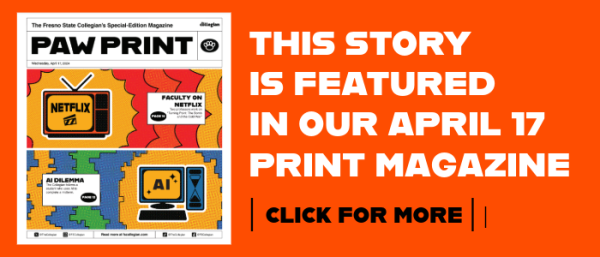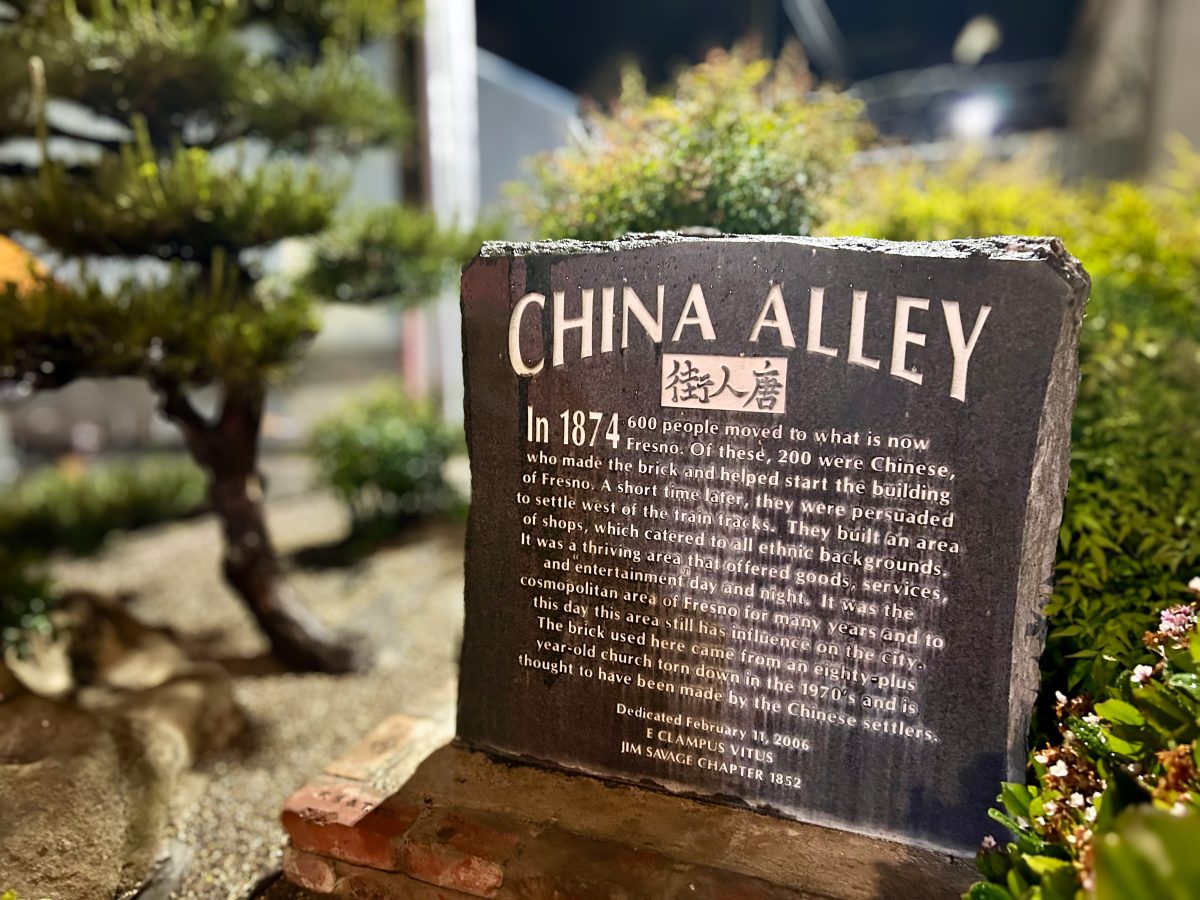Just west of the railroad tracks in Fresno lies a forgotten community. Once rich in culture, life and prosperity, Chinatown has now become a town bursting with potential for resurgence after undergoing years of transformation due to industrialization.
“The revitalization of Chinatown is not going to happen; it’s happening right now,” said Morgan Doizaki, owner of Central Fish Company Fresno.
Present-day Chinatown is a tight-knit community of resilient business owners, featuring numerous shops and restaurants. The identity of this community lies in the family-owned businesses passed down to a new generation, and the original owners who offer authentic cuisine that is traditional to their cultures.
From the beginning of the building of Chinatown to the now-empty land parcels where thriving family-owned businesses once stood, the culture survives. It resembles a graveyard with remnants of its former vibrancy.
Just a 15-minute drive from Fresno State, Chinatown is home to many historical buildings that fill the streets with history and culture. As one navigates through the community, vacant buildings, graffiti-riddled walls and chain-link fences mark areas where construction is underway for the High-Speed Rail project.
The High-Speed Rail project could play a pivotal role in Chinatown’s revitalization and Fresno’s future. The current plan is to prepare for this project so that when it is finished, visitors may stop in Chinatown and experience a thriving community once again.
However, there is no guarantee that the High-Speed Rail will benefit Chinatown or Downtown Fresno at all.
The current construction has blocked off streets that are imperative to connecting people to the businesses that inhabit Chinatown. Consequently, many businesses have suffered and had to reduce their hours or days of operation due to the efflux of visitors.
Unable to navigate the streets because of the construction, visitors are unaware of where to go and how to get there, causing a disconnect between consumers and the ability to locate these shops.
“It affects my business because people can’t get here anymore,” Doizaki said. “They don’t know how to navigate through here. They shut down Kern Street forever and Tulare Street is still closed.”
Though the economic state of businesses has changed drastically, business owners have stood resilient through the difficult times.
Chinatown residents have begun to find new ways of communicating to the public that Chinatown is well, alive and open for business. Through events such as the 559 Night Market that highlights local food, businesses and shops, they have been able to increase visitors and advertise the businesses that currently exist.
There are also businesses such as Ms. Limón V and Kordova Co. that host a monthly fashion show during ArtHop in order to promote and encourage visitors to come to Chinatown.
The community is currently undergoing urban renewal projects with the intention to breathe life back into Chinatown and revive it. This project, a $66.5 million grant from the Transformative Climate Communities Collaborative, hopes to infuse Chinatown with much-needed economic and environmental changes.
“We’re always building for the future, so what was good enough 20 years ago isn’t good enough for ten years from now, but when you’re already struggling it is one more thing,” said Elliott Balch, president and CEO of Downtown Fresno Partnership.
One completed project that has brought positive change to the community is The Monarch, a mixed-use development building that is environmentally friendly, creates affordable housing and encourages economic growth as well as attracting new residents to settle into the Chinatown area.
“It’s the first housing project in Chinatown’s history in the last 75 years,” said Miguel Arias, councilmember for District 3 which includes Chinatown. “It’s called The Green Building because everything is super energy-efficient.”
Chinatown, though having gone through changes throughout the years, stands tall in the preservation of the culture of generations of Asian-Americans and a multitude of cultures and histories.
Built on the foundation of racism and segregation, the story of Chinatown begins in the late 1800s when original Chinese immigrants came to California looking for opportunities. Due to the federal Chinese Exclusion Act, immigrants were not allowed to bring in their families.
In the 1930s, redlining, the discriminatory practice, where financial services are withheld from neighborhoods with significant numbers of racial and ethnic minorities, prevented Chinese immigrants from owning property and building businesses. Those seeking opportunity were forced to move to the other side of the tracks, where they built Chinatown.
Later in the 1950s and 60s, highways, such as Highway 99 were built and designed to specifically segregate communities.
“The designer of the highway system intended to separate communities of color from downtowns and it separated the residential community,” said Jan Minami, the project director of the Chinatown Fresno Foundation.
Although this was a time when racially segregated enclaves were the norm, a newly diverse city was born. A community of bustling businesses, restaurants and entertainment centers ran from sunup to sundown.
Undeterred by the discrimination and segregation they faced, they built a city that became the center of culture and life for locals and those in nearby towns. As time went on, the diversity of inhabitants grew, and many people came to bask in the community that was Chinatown.
“There were many cultures that called this place home; we recognize the 11 founding cultures and because they weren’t the white man, this was our downtown,” said Doizaki.
Since the beginning of the creation of Chinatown, industrialization has been both the rise and downfall of Chinatown. The building of the railroad and highways separated Chinatown from the rest of Fresno, turning it into an island.
The physical separation of Chinatown from everything else was a prime example of the segregation and discrimination that this community faced at the time. As years went on and segregation laws were lifted, people of color were then allowed to buy property on the other side of the tracks, so they did.
Tenants moved out, leaving buildings vacant and neglected. This overall took away from the vibrance of Chinatown, and the once-lively community was no longer. In the 1960s, redevelopment agencies were formed to rid the community of buildings that were considered blighted.
“It should have been a thoughtful process if that’s what they intended to do,” said Minami. “They destroyed what they considered blight and they built nothing.”
Due to the abrupt migration of residents, there are 120 parcels in Chinatown, yet 43 of the parcels are flat ground with no plans of building anything.
Building on these lands would cost a substantial amount of money, as historically these buildings were heavily industrial buildings that released toxic chemicals and carcinogens.
“Essentially Chinatown has become a series of land parcels that have some significant levels of contamination because of historical industrial use,” said Arias.
Most of the parcels are owned by those hoping that the building of the high-speed rail will mean the offer of substantial amounts of money for their parcel of land or what is otherwise known as “sitting on property,” Arias said.
The future of Chinatown looks promising as renovations remain to revitalize the community through numerous projects. The goal is less to get it back to what it was and more to look toward the future and progress into a better flourishing community.
“It’s funny; the city’s racist policies were the reason Chinatown was built and thriving,” Arias said. “Now the city is trying to rectify that historic wrong by reinvesting in it.”
What that looks like is an image that will take time to develop. Over the years there are several projects and changes that Chinatown will go through to capitalize on the potential and room for growth that this community has.
The building and completion of the High-Speed Rail in the next decade could open the possibility of an influx of visitors to the Chinatown area, leaving room to expand in hopes of attracting customers, business owners and housing for new generations of inhabitants and entrepreneurs in the area.
This will happen all while preserving the preexisting businesses and creating a new, bigger consumer base for these local restaurants and shops in hopes that the expansion and revitalization of Chinatown will rebuild the community.
“Our goal is to empower the people in the neighborhood to create a better neighborhood,” Minami said.
Over the next 10-20 years, the development of the community is imperative to the future growth of Chinatown and its overall success. The hope is that a historically prosperous community can once again fill the streets with life and be revived into a vibrant, growing neighborhood.
“The future is bright except there’s a lot of growing pains, and I look forward to the future because we’re positioning ourselves to take advantage of what’s coming,” Doizaki said.
The story of what Chinatown is, was and what it can be, all point toward a promising future. The city was built on the richness of culture and life that remains to this day. The changes and trials that this city within a city has gone through only confirms that history is alive and the future is coming.





